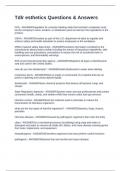Tdlr esthetics Questions & Answers
FDA - ANSWERSregulates for cosmetic labeling state that cosmetic companies must
list the company's name, location, or distribution point as well as l the ingredients in the
product.
OSHA - ANSWERScreated as part of the U.S. department of labor to regulate and
enforce safety and health standards to protect employees in the workplace.
MSDS material safety data sheet - ANSWERScontains information compiled by the
manufacturer about product safety including the names of hazardous ingredients, safe
handling and use procedures, precautions to reduce the risk of accidental harm or
overexposure, and flammability warnings
EPA environmental protection agency - ANSWERSRegisters all types of disinfectants
sold and used in the United States.
How do you mix disinfectant? - ANSWERSadd disinfectant to water when diluting
nonporous items - ANSWERSitem is made or constructed of a material that has no
pores or opening and cannot absorb liquids.
disinfectant - ANSWERSare chemical products that destroy all bacteria, fungi, and
viruses
State Regulatory Agencies - ANSWERSprotect salon and spa professionals and protect
consumers health, safety, and welfare while they recieve salon and spa services
infection control - ANSWERSAre the methods used to eliminate or reduce the
transmission of infectious organisms.
what are the four types of harmful organisms? - ANSWERSbacteria, fungi, viruses,
parasites
infectous disease - ANSWERSCaused by pathogenic organisms that enter the body
clean - ANSWERSis a mechanical process (scrubbing) using soap and water or
detergent and water to remove all visible dirt, debris, and many disease-causing germs
from tools, implements, and equipment
Nonpathogenic - ANSWERSHarmless organisms that may perform useful functions
pathogenic - ANSWERSBacteria that are harmful and cause disease
,Cocci - ANSWERSare round-shaped bacteria that appear singly (alone) or in groups
Staphylococci - ANSWERSPus-forming bacteria that grow in clusters like a bunch of
grapes. They cause abscesses, pustules, and boils.
Diplococci - ANSWERSSpherical bacteria that grow in pairs and cause diseases such
as pneumonia.
Bacilli - ANSWERSAre short,rod shaped bacteria.
Spirilla - ANSWERSAre spiral of corkscrew-shaped bacteria.
direct transmission - ANSWERSTransmission of blood or body fluids through touching
(including shaking hands), kissing, coughing, sneezing, and talking.
indirect transmission - ANSWERSTransmission of blood or body fluids through contact
with an intermediate contaminated object such as a razor, extractor, nipper, or an
environmental surface.
infection - ANSWERSinvasion of the body by a pathogenic organism
germs - ANSWERSNonscientific synonym for disease-producing organisms
immunity - ANSWERSis the ability of the body to destroy and resist infectection
natural immunity - ANSWERSImmunity that is partly inherited and partly developed
through healthy living.
acquired immunity - ANSWERSimmunity that the body develops after it overcomes a
disease, or through inoculation (such as vaccination)
what decontamination method 1 is useful for? - ANSWERScleaning and then
disinfecting with an appropriate EPA-registered disinfectant
decontamination method 2 - ANSWERSCleaning and then sterilizing
microorganism - ANSWERSAny organism of microscopic or submicroscopic size.
what are the three way to clean your tools or implements? - ANSWERS-washing with
soap and warm water, then scrubbing them with a clean and properly disinfected nail
brush
-using ultrasonic unit
-using a cleaning solvent
tinea pedis - ANSWERSA ringworm fungus of the foot
,Virucidal - ANSWERSCapable of destroying viruses
what is the common household bleach; an effective disinfectant for the salon? -
ANSWERSsodium hypochlorite
scables - ANSWERSa contagious skin disease that is caused by the itch, mite, which
burrows under the skin
Parasites - ANSWERSOrganisms that grow, feed, and shelter on or in another
organism (referred to as the host), while contributing nothing to the survival of that
organism. Parasites must have a host to survive.
Toxins - ANSWERSVarious poisonous substances produced by some microorganisms
(bacteria and viruses).
contamination - ANSWERSThe presence, or the reasonably anticipated presence, of
blood or other potentially infectious materials on an item's surface or visible debris or
residues such as dust, hair, and skin.
Decontamination - ANSWERSThe removal of blood or other potentially infectious
materials on an item's surface and the removal of visible debris or residue such as dust,
hair, and skin.
Papules - ANSWERS
Pustules - ANSWERS
vitiligo - ANSWERS
actinic keratosis - ANSWERS
infectious disease - ANSWERSA disease that is caused by a pathogen and that can be
spread from one individual to another.
Keratosis Pilaris - ANSWERS
vesicles - ANSWERS
verruca - ANSWERS
Shingles - ANSWERS
Keloids - ANSWERS
tinea corporis - ANSWERS
, pathogenic disease - ANSWERSDisease produced by organisms, including bacteria,
viruses, fungi, and parasites.
comedones - ANSWERS
Milia - ANSWERS
seborrheic dermatitis - ANSWERS
Hepatitis - ANSWERSis a blood borne virus that causes disease and can damage the
liver
contact dermatitis - ANSWERS
eczema - ANSWERS
Folliculitis - ANSWERS
Psoriasis - ANSWERS
Rosacea - ANSWERS
symptoms range from redness, swelling, scaling, and itching to serious, painful
chemical burns is called what? - ANSWERSirritant contact dermatitis
Allergic contact dermatitis - ANSWERSallergic contact dermatitis is caused by exposure
and direct skin contact to an allergen
basal cell carcinoma - ANSWERS
squamous cell carcinoma - ANSWERS
malignant melanoma - ANSWERS
acids - ANSWERSsubstances that have a pH below 7.0 taste sour, and turn litmus
paper from blue to red
Alkalis - ANSWERSknow as bases, have a pH above 7.0, taste bitter, and turn litmus
paper from red to blue
what is the pH neutral solution? - ANSWERS7
Retinol - ANSWERSvitamin A. stimulates cell repair and helps to normalize skin cells by
generating new cells




